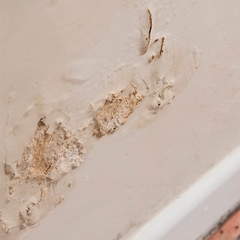Blog Post
Water Damage Tips – How to Detect and Solve Water Damage Problems

After your home or business has a water incident, some of water damage won't be easily detected. In fact, scientifically, our human bodies only have the ability to discern moisture content intelligently. For example, touch you skin. It FEELS dry BUT it is 98% water. So one knows that it is technically saturated but our brains simply don't have the ability to FEEL this form or moisture. So many times we have heard the phrase from any given customer, "it feels dry so we're good." This is not a true statement. In MOST every instance, I have put a meter specifically designed to discern moisture levels on the wall that FEELS dry and indeed it will have elevated moisture levels that need to be addressed to prevent further damage. The following are some ways to detect that you have water damage in your home or office.
Peeling/Blistering Paint
Typically found on walls and/or ceilings where exterior envelopes of the structure have been compromised (roofs, siding, etc).
Spongy Floors
This is most often found around refrigerators, bathtubs and laundry rooms. It is typically the result of slow leaks that evolve over time and are discovered suddenly.
Stale or Musty Smells
This is another indicator that airflow is not properly maintained OR it could be as simple as building an enclosure to disallow airflow from an open crawl space into the living space of one's home.
Visible Mold and/or Rot
Mold is typically found in areas where moisture, still air, and food are available for the spread of the organism. Generally speaking it is an indicator of a direct water loss that has not been properly addressed (repaired, structural drying, etc) OR elevated relative humidity (RH) levels are continually above 55-60%. Mold CAN be a problem and largely depends upon sensitivity levels of the individual and exposure levels. Specific allergic reactions to specific mold types must be determined by medical authorities. There are some 100,000 identified species of mold – so which one, to some degree, can be irrelevant. The fact that mold is propagating should be the focus of any attention. All types will be removed during the mitigation process. The key to mold assessment is to determine the source of moisture intrusion or why RH levels are elevated above normal in the first place. This is the first step.
Also, most of today's homes are built efficiently to seal in heat and air conditioning. That is great in keeping your home cool or warm. However, the lack of proper air flow can lead to problems! Homes MUST breath and allow air exchanges to take place. When air exchanges are not allowed to occur, the air grows stagnant which is a great environment for light levels of mold growth. When one finds mold on shoes in a closet or in corners where furniture sits this is a reason to have this issue looked into.
Why You Should Call a Professional
If you suspect a leak or possible water damage to your home it is best to call a professional. A professional will know exactly where to detect problems that can be hidden to the naked eye. Also a professional will have the proper equipment to dry-out your home and get your family back to living in a healthy home.
1st Call Disaster Services specializes in finding and eliminating water leaks and dealing with mold issues if they are found.
A good restoration company can make sure a mold remediation is done right and that you're out of pocket damage liability is kept to a minimum. We've helped numerous home and business owners and they and their insurance company always appreciate our surgical approach to restoration!
